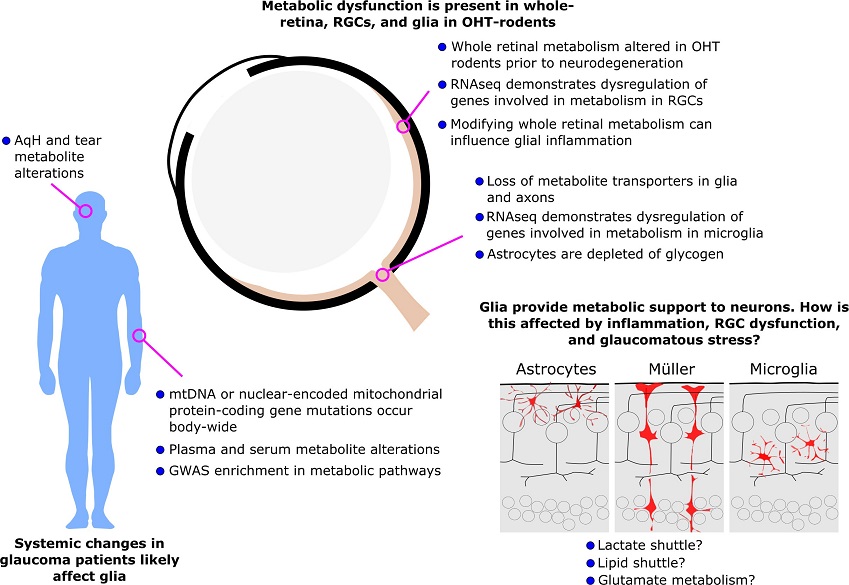Glaucoma News: Swedish Study Shows Glial Metabolic Alterations During Glaucoma Pathogenesis!
Nikhil Prasad Fact checked by:Thailand Medical News Team Nov 28, 2023 1 year, 4 months, 3 weeks, 1 day, 9 hours, 20 minutes ago
Glaucoma News: Glaucoma, a relentless adversary leading to irreversible blindness, is a global health concern affecting over 80 million diagnosed individuals, with an additional undiagnosed cohort of similar magnitude. Amidst established risk factors such as age, genetics, and elevated intraocular pressure (IOP), a paradigm-shifting study from the esteemed Karolinska Institutet in Sweden has spotlighted metabolic dysfunction as a pivotal element in glaucoma's intricate pathophysiology. This groundbreaking research covered in this
Glaucoma News report not only reveals metabolic shifts within glial cells but also charts a course toward a more profound comprehension of the neurodegenerative processes underpinning this vision-threatening condition.
 Graphical Abstract
The Global Burden of Glaucoma
Graphical Abstract
The Global Burden of Glaucoma
Glaucoma's impact on global visual health is staggering, affecting millions and underscoring its significance as a public health concern. At its core lies the gradual degeneration of retinal ganglion cells (RGCs), the vital conduits for visual information. While traditional risk factors such as age, genetics, and elevated IOP are recognized, current treatment approaches primarily address IOP reduction, leaving a critical gap in tackling the underlying neurodegenerative mechanisms.
Metabolic Dysfunction Unveiled
Recent research has thrust metabolic dysfunction into the spotlight as a central and persistent player in glaucoma's pathophysiology. This paradigm shift positions metabolic disturbances as critical early indicators and contributors to glaucoma progression. Notably, these metabolic alterations extend across genomic and mitochondrial DNA levels, affecting retinal cells, visual system tissues, ocular fluids, and blood/serum. This systemic perspective emphasizes the pervasive nature of metabolic dysfunction in glaucoma.
Retinal Ganglion Cells: Metabolic Vulnerability
RGCs, essential for vision, display heightened vulnerability to metabolic disturbances. Their structural characteristics, including long unmyelinated axons and a high density of mitochondria, render them susceptible to mechanical stress and IOP-related strain. Energy demands are delicately balanced between glycolysis and oxidative phosphorylation, relying on a robust supply of nicotinamide adenine dinucleotide (NAD) and other critical metabolites. A decline in retinal NAD levels serves as an early marker of metabolic compromise in both animal models and human glaucoma patients.
Metabolic Dysfunction Beyond RGCs
t;
Contrary to initial focus, metabolic dysfunction in glaucoma extends beyond RGCs. Genetic analyses have identified mutations in both mitochondrial and nuclear-encoded mitochondrial protein-coding genes in patients with primary open-angle glaucoma (POAG) and normotensive glaucoma (NTG). Systemic manifestations, including impaired mitochondrial activity in lymphoblasts and ocular fibroblasts from glaucoma patients, underscore the widespread impact of glaucomatous metabolic alterations.
Glial Metabolic Changes: A New Frontier
The Karolinska Institutet study delves into uncharted territory: metabolic alterations within glial cells in glaucoma. Glial cells, comprising microglia, astrocytes, and Müller cells, play pivotal roles in supporting RGCs. Inflammation, a well-established facet of glaucoma pathology, induces shifts in glial populations toward pro-inflammatory phenotypes, complicating the metabolic landscape. The activation of AMP-activated protein kinase (AMPK), an energy sensor, in response to intracellular ATP decreases, extends beyond RGCs to glial cells, emphasizing the direct impact of IOP-induced stress on glial metabolic function.
Implications and Future Directions
The recognition of glial metabolic alterations opens new vistas for therapeutic interventions in glaucoma. The intricate interplay between glial cells and RGCs, exacerbated by inflammatory shifts and metabolic stress, unveils a complex tapestry that demands further exploration. The identification of shared neuroprotective targets in glial and RGC metabolism presents an optimistic prospect for the development of targeted treatments addressing the multifaceted nature of glaucoma pathophysiology.
Unraveling the Glaucomatous Metabolic Enigma
In light of the study findings, glaucoma's metabolic landscape demands a closer look. Beyond the traditional focus on RGCs, the study underscores the systemic impact of metabolic dysfunction. Insights into mitochondrial and genomic alterations offer a holistic understanding of glaucoma's complexity, paving the way for more nuanced treatment strategies.
The Glial Factor - Illuminating Metabolic Dynamics
The study's revelation of metabolic shifts within glial cells adds a new layer to our comprehension of glaucoma. Microglia, astrocytes, and Müller cells, once considered secondary players, emerge as key contributors to the metabolic intricacies of the disease. Their transition to pro-inflammatory phenotypes underlines the dynamic interplay between inflammation and metabolism, with implications for RGC support and neurodegeneration.
Metabolic Resilience and Vulnerabilities
While RGCs remain focal points of metabolic vulnerability, glial cells showcase a certain degree of resilience in the face of early glaucomatous stress. The activation of AMPK in glia suggests an adaptive response to IOP-induced stress, potentially influencing the delicate balance between glycolysis and oxidative phosphorylation. Glial cells, particularly astrocytes, display metabolic flexibility, offering a buffer against immediate metabolic depletion.
Therapeutic Avenues: Targeting Shared Neuroprotective Targets
The identification of shared neuroprotective targets in glial and RGC metabolism heralds a new era in glaucoma therapeutics. By addressing the intricate interplay between glial cells and RGCs, novel treatments can transcend conventional IOP-focused approaches. The potential for targeted interventions, leveraging our evolving understanding of metabolic dynamics, offers hope for halting or slowing glaucoma progression.
Conclusion
The Karolinska Institutet's groundbreaking study propels glaucoma research into uncharted territory, unraveling the metabolic intricacies that underlie this vision-threatening condition. Metabolic dysfunction, extending beyond RGCs to encompass glial cells, emerges as a central player, urging a paradigm shift in therapeutic approaches. As the global burden of glaucoma persists, this newfound understanding of glaucoma's metabolic landscape ignites hope for innovative treatments, steering us closer to a future where irreversible vision loss is no longer an inevitable consequence of this insidious disease.
The study findings were published in the peer reviewed journal: Frontiers in Ophthalmology.
https://www.frontiersin.org/articles/10.3389/fopht.2023.1290465/full
For the latest
Glaucoma News, keep on logging to Thailand Medical News.
